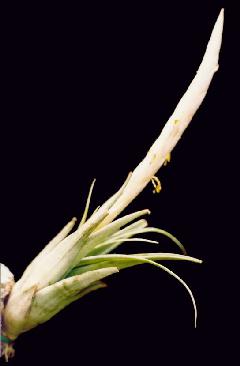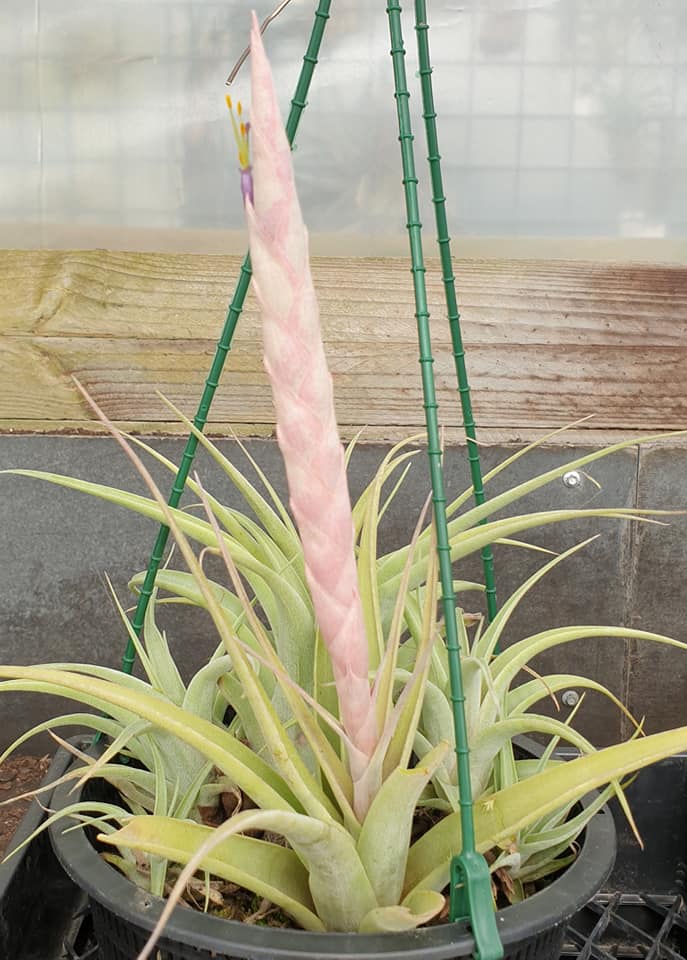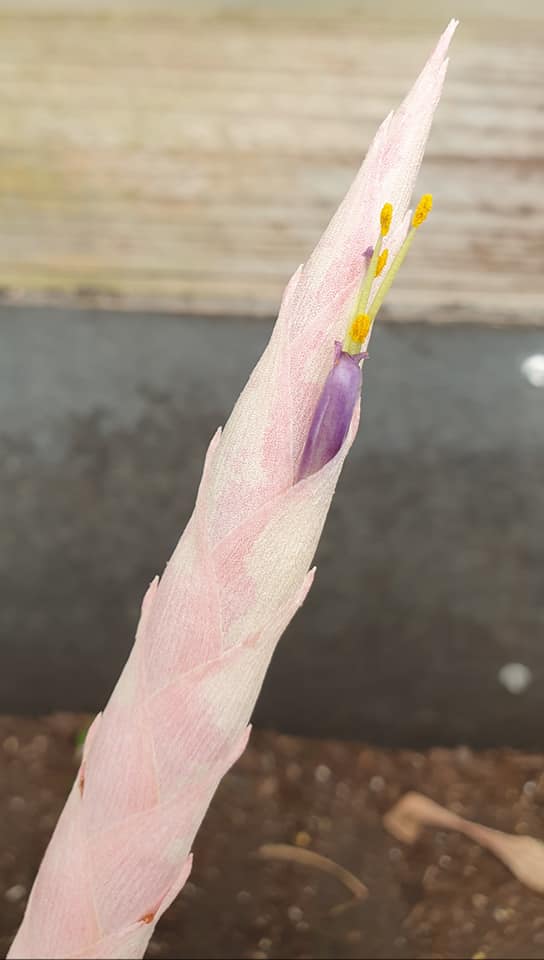


From Jour. Bromel. Soc. 21: 67, figs. 1971. by W Rauh
On my bromeliad collecting trip through Mexico in 1966 I collected in the dry and semi-arid region between Tehuacan and Teotitlan an interesting Tillandsia (Rauh Coll. Nr. RM 15447), growing on big cacti, such as Neobuxbaumia, Cephatocereus hoppenstedtii and in association with Tillandsia mackoyana and others. L. B. Smith, to whom I sent herbarium material, identified this plant as Tillandsia achyrostachys.
It is true that RM 15447 is closely related to T. achyrostachys, but it differs in some remarkable points: I found RM 15447 only on cacti or on succulent Liliaceae as Beaucarnea gracilis, whilst T. achyrostachys prefers trees, especially Burseras, Acacias and others; it is much bigger; the inflorescence spike is longer (up to 60 cm). But the main differences to T. achyrostachys are the pale carmine-red, nearly whitish, densely white lepidote flower bracts, the dark blue-violet flowers, while these are pale yellow green in T. achyrostachys and the flower bracts of a bright carmine red color with prominent nerves. (See color photo 20 in: RAUH, Bromelien, 1970). Some months ago the plant flowered in the famous bromeliad collection of my friend, Julien Marnier-Lapostolle, St.Jean Cap Ferrat (France). He again sent material and photographs to L. B. Smith and he is now, according to this material, of the same opinion as the author, that means that L. B. Smith regards RM 15447 also as a new species.
In recognition of his interest in the genus Tillandsia, we dedicate the plant to Prof. Dr. Luigi Califano, Napoli.
Following the diagnosis:
Tillandsia califani RAUH spec. nov. Jour. Bromel. Soc. 21: 67, figs. 1971.
Tillandsiae achyrostachyi E. Morr. affinis, sed ab ea differt foliis longioribus dense cano-squamosis, bracteis floralibus roseis et floribus obscuro-caeruleo-violaceis. Acaulis, cum inflorescentia usque ad 80 cm alta; folia usque ad 12 in rosulam laxam ad 30 cm diametientem disposita; vaginae foliorum indistincte limitatae oblongo ovatae, usque ad 6 cm longae, 4 cm latae dense cano-squamosae; laminae plus minusve 30 cm longae supra vaginam 3,5 cm latae marginibus valde erectis, anguste lanceolatae, paulatim longe acuminatae, dense cano-squamosae; scapus erectus, 15 - 20 cm longus; folia scapi erecta, basalia lamina longa angusta foliis rosulae similia; inflorescentia simplex, spicata, gladiata, usque ad 50 cm longa, 2 - 3 cm lata; bracteae florales imbricatae, dorso rotundatae pallide roseae, rarius virides, dense cano-squamosae; sepala libera, membranacea, alba, 3 cm longa, 9 mm lata lanceolata; petala 6 cm longa, 6 mm lata obscuro-caeruleo-violacea, tubum angustum formantia; antherae et stylus usque ad 1 cm e flore exsertae.
Habitat: Mexico, prope Teotitlan (Tehuacan)
Holotypus; Rauh Nr. Coll. RM 15 447 (19GG), in herbario Heidelbergensi (HEID) conservatur.
Plant stemless, flowering up to 80 cm high.
Leaves about 15, in a £unnelform rosette, up to 40 cm long.
Sheaths indistinct, up to 6 cm long and 4 cm wide at the base; densely brown lepidote;
blades narrowly triangular, about 30 cm long, 3,5 wide above the sheath, long attenuate, tapering gradually into a thin, curved tip, drying up very early; their margins curved upwards, densely grey-brown lepidote.
Scape stout, erect, 20 - 30 cm long, shorter than the rosette leaves;
scape bracts erect, the lower ones subfoliaceous with a short linear blade; the upper ones broadly ovate, apiculate; pale carmine red, exceeding the internodes.
Inflorescence a simple spike, up to 50 cm long and 2-3 cm wide.
Floral bracts densely imbricate, shortly apiculate, rounded at the back, pale carmine red with whitish, adpressed scales; their nerves not so prominent as in the flower bracts of T. achyrostachys.
Flowers dark blue violet, exceeding the flower bracts.
Sepals free, membranaceous, up to 3 cm long, 9 mm broad, lanceolate, white; to pale green;
petals forming a narrow tube, up to 6 cm long and 6 mm broad, much more longer than the sepals.
Stamens and style exceeding the flower tube;
anthers pale yellow-green, style and stigmas violet.
From Smith in Phytologia 28(1): 30. 1974
At first glance T. califanii so closely resembles T. achyrostachys that it is easily mistaken for that species. However, its densely lepidote floral bracts quickly distinguish it and even bring it out to a different position in the key from T. achyrostachys.
The leaf-sheaths are slightly different from the original description in that their scales are brown-centered like those on the blade. The sheath-color is derived from the dark tissue below showing through the large pale scale-margins and covers only the base of the sheath.